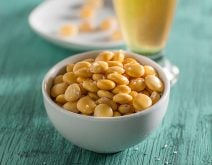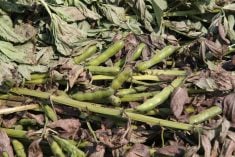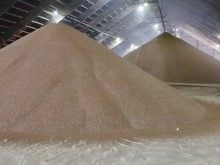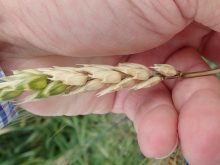A new study being conducted in Western Canada could soon provide growers with valuable insights on how to achieve more productive, sustainable and resilient cropping systems.
Resilient Rotations is a comprehensive research project that aims to develop a new approach to crop rotations. The five-year study is being managed as part of the Integrated Crop Agronomy Cluster (ICAC) with research being conducted by Agriculture and Agri-Food Canada (AAFC) and several universities and industry partners at field sites in Manitoba, Saskatchewan and Alberta.
The study is focusing extension efforts on four key indicators of crop rotation performance — yield, economics, precipitation use efficiency and nitrogen fertilizer use efficiency. A total of six different rotation types are being tested in three different regions — the northern Prairies, southern Prairies and Manitoba’s Red River Valley.
Read Also

Claas brings 1000 Series SP forage harvesters to Canada
In mid-August, Claas unveiled its new line of Jaguar forage harvesters at an event in Visalia, California, deep in the heart of that state’s dairy region.
The ultimate goal of the project is to provide growers with science-based, region-specific information on the benefits of implementing more diversified rotations on their farms, says Sheri Strydhorst, a former agronomy research scientist who is serving as an extension specialist with the project.
“I think when we look at the rotations farmers are using on the Prairies, they are short and simple, often being a cereal and an oilseed. Growers are driven to that for ease of growing those crops and economic reasons,” she says.
Benefits of diverse rotations
“This project came together so we could look at how we can really give farmers convincing evidence that more diverse rotations do have benefits on farms in terms of the health of their system and the economics of their system (to) try and give a little more evidence to diversify rotations in Western Canada,” says Strydhorst.

Resilient Rotations is being funded by the federal government through the Canadian Agricultural Partnership and has received matching industry funding from a list of groups including the Western Grains Research Foundation, Alberta Pulse Growers, Alberta Wheat Commission, Manitoba Crop Alliance, SaskCanola and the Sask Wheat Development Commission.
The first phase of the study includes data from the 2018-2022 growing seasons and is slated to wrap up in early 2023. A five-year second phase of the project could begin later in 2023 pending funding approval.
The six types of rotations being reviewed as part of the study include the following:
- Control rotation — Incorporates widely used cropping rotations as a reference point.
- Intensified rotation — Uses canola in the northern region and pulses in the southern region, depending on the local environment.
- Diversified rotation — Includes a different crop each year as part of an effort to see how diversified rotations affect agro-ecosystems.
- Market-driven rotation — A rotation based on gaining farmers the maximum economic benefits.
- High-risk rotation — This rotation is focused on introducing new crop types for the geographic region that, in the past, may not have worked but might be considered now because of breeding to make these crop types more widely adapted.
- Soil health rotation — This final rotation includes the incorporation of green manure with an overall goal of improving soil health.
The results of the different rotations were compared using a tool referred to as canola equivalent yield (CEY). CEY standardizes yields between different crops using a price ratio relative to canola that allows dissimilar crops with different potential yields to be compared in a fair and meaningful way.
A different approach
Kui Liu, a research scientist based at AAFC’s Research and Development Centre in Swift Current, says what makes this study different from other similar studies is it takes a systems approach rather than focusing on a single factor such as yield or disease.
“We are using multiple systems indicators to try and do a fair assessment of these various cropping systems,” he explains.

Liu says the three regions were chosen as part of an effort to represent the different ecozones that make up the Canadian Prairies and the conditions farmers in those areas have to contend with. The northern Prairies region includes Beaverlodge and Lacombe in Alberta and Melfort and Scott in Saskatchewan, while the southern Prairies is comprised of Lethbridge, Alta., and Swift Current, Sask. And Carman, Man., makes up the Red River Valley region (results will be available for this region in early 2023).
“The results that come out of this project should be very representative of the whole Canadian Prairies,” he says, adding that this will allow researchers to develop site-specific cropping rotations for a variety of different ecozones and thereby help producers avoid failure.
While the study is aimed primarily at helping growers boost yields, improve economics and reduce their carbon footprints, Strydhorst says a secondary goal is to provide industry with science-based evidence to respond to the increased scrutiny it now faces from customers.
“This (study) is trying to provide data over a large landscape about the health of our systems, about how we’re making the most use of rainfall, how we make the most use of the fertilizers we use and so on,” she explains.
“I think this research will be able to provide some of that factual content needed to help support decision-making at the policy and marketing levels,” she adds.
One of the preliminary findings of the study is there wasn’t one particular rotation that fared well at all of the test sites, she says. “There was not a consistent winner. I would say there were winning traits of rotations and that’s typically common where the more species, the better. For example, rotations with pulse crops were usually better.”
Yield and yield stability results
Results of the Resilient Rotations study on yield and yield stability in the northern and southern Prairie regions were released late last year. Results for the Red River Valley region are expected in early 2023.
Most of the high-risk rotations used in the study consistently performed poorly, Strydhorst noted.
Rotations focused on improving soil health also performed poorly in terms of yield and yield stability, something Strydhorst chalks up to the rotations having no yield for one year during the five-year project cycle in order to add green manure to the soil. Liu says one of the hopes is the soil health rotation results will help farmers to better understand how green manure (crops grown to add nutrients and organic matter to soil) works in cropping systems.
In the northern region, the market-driven rotation consisted of a four-year cycle of canola-malt barley-canola-canola in Beaverlodge and Lacombe, Alta., and oat-canola-wheat-canola in Melfort and canola-canola-green pea-canola in Scott, Sask.
In the southern region, the market-driven rotation was comprised of flax-wheat-lentil-feed barley in Swift Current, Sask., and canola-wheat-wheat-malt barley in Lethbridge, Alta.

The market-driven rotation appeared to perform well in both areas of the northern region. Strydhorst says this didn’t come as much of a surprise since that rotation was comprised largely of canola and the price ratio favours canola, which skewed things in its favour. It also performed well in Lethbridge but had a lower CEY rating in Swift Current. Liu says the market-driven rotation’s slightly better performance in the northern region was likely because it has a higher yield potential than the southern region.
A diversified crop rotation of pea-winter wheat-faba bean-canola produced high yields in the Alberta portion (Beaverlodge and Lacombe) of the northern Prairies but resulted in a significantly lower CEY rating in Saskatchewan (Melfort and Scott). Strydhorst says the poorer performance of the diversified rotation in some areas may be attributed to a lack of moisture and the fact that winter wheat doesn’t do well if there is a dry spring. Meanwhile, a diversified rotation of lentil-canola-pea-durum in the southern Prairies region performed strongly in Lethbridge but less so in Swift Current.
An intensified rotation of wheat and canola every other year produced mixed results in the northern Prairies region, but an intensified mixture of lentil-durum-chickpea-durum performed strongly throughout the southern Prairies. Strydhorst notes the strong performance of the intensified rotation in the southern region may be attributed to those crop types being well suited to the drier conditions during the time of the study.
Bigger picture
Although the data on yield is valuable, Liu and Strydhorst both stress it’s important to remember it offers a partial picture of the value of diversified rotations.
“I know producers, including myself, we can get tunnel vision and think that’s all we need to look at. But we need to remind ourselves there’s more to this story,” she says. “In the days to come, we will be talking about precipitation efficiency. Once we get to that and nitrogen use efficiency and the economic piece, that will round out the story.”
Liu says he is eager to continue the project for a second five-year study period as it would produce more robust results and help to better determine the resiliency of the different cropping systems in a wider variety of weather and soil scenarios.
Easy-to-read fact sheets that summarize the above data can be found at the WGRF website.
















